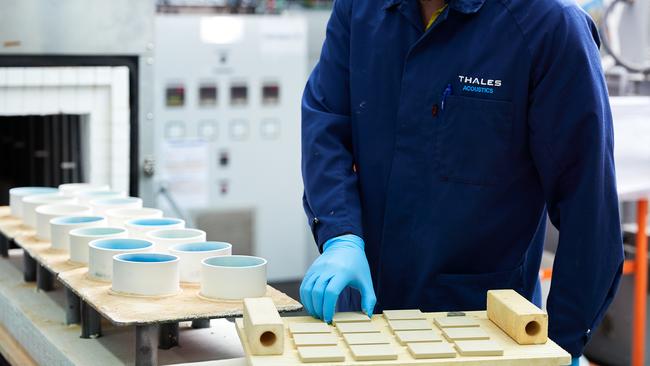DMTC leads piezoelectric R&D
A team of Australian researchers is now working on the third generation of piezoelectric materials – single crystal devices, replacing current polycrystalline materials.

If you’ve ever used a gas match to light a barbecue, then you’ve used a piezoelectric device. When you squeeze a piezoelectric ceramic crystal it emits an electric current: in a gas match you get a spark that ignites a gas flame. But if you put that crystal in a sonar sensor you get a tiny pulse of electricity that can betray the presence of a submarine or an entire surface fleet, tens of kilometres away.
Jointly funded by DST Group’s Next Generation Technologies Fund (NGTF) and Thales Australia, a team of Australian researchers led by Melbourne defence commercialisation specialist DMTC Limited is now working on the third generation of piezoelectric materials – single crystal devices, replacing current polycrystalline materials.
Single crystal piezoelectric devices have their crystalline structure aligned in the same way, rather than being aligned randomly. While much harder to manufacture, this structure increases by an order of magnitude the sensitivity and bandwidth of sonars and underwater guidance systems.
DMTC’s ultimate goal is to establish a sovereign design and manufacturing capability for single crystal sensors in Australia.
The Australian market demand to justify this R&D investment certainly exists. The Navy could be spending up to $25bn over the next 15-20 years on new sonars for its existing and future submarines, Hunter-class frigates and Hobart-class destroyers, Unmanned Underwater Vehicles for mine hunting, and a new Undersea Surveillance System. Piezoelectric crystals are used in the sonar transducers that turn minute acoustic vibrations into symbols on operators’ screens, telling them where, and very often what, the source of the noise is.
The five-year Advanced Piezoelectric Materials and Applications (APMA) program which began last year is led by DMTC. It aims to establish a strategic national capability by, first, characterising single-crystal piezoelectric materials so that sensor design can be tailored to the enhanced qualities of the material. It then aims to establish a foundry at Thales Australia’s Acoustics Centre of Excellence in Rydalmere, NSW, where single crystal materials can be grown in commercial quantities to replace imports from the US and Asia and eventually compete on the export market.
Materials scientists from the Australian Nuclear Science and Technology Organisation (ANSTO) are using the organisation’s highly specialised laboratories and test facilities at Lucas Heights to conduct much of APMA’s R&D.
“Over the last six years we have developed a very particular technique on a commercial basis – which has now been transferred to our client, Thales,” says Professor Mihail Ionescu, ANSTO’s leader of nuclear fuel cycle research.
Although piezoelectric materials are not its core business, ANSTO has the skills required and is now training Thales personnel in this technique.
Thales Australia is doing most of the rest of the R&D on a self-funded basis in Rydalmere, according to Tim Cain, the company’s technical director underwater systems.
You get much greater electrical output from a single crystal device for a smaller force, according to Cain, and sensors can therefore be smaller and lighter. So, instead of having separate sonars on a submarine, for instance, each designed to detect acoustic signals at a different frequency, you might in the future have fewer, lighter, more versatile sonars which are also much more sensitive and with much greater range and discrimination.
Thales Australia exports more than 80 per cent of the piezoceramic crystal output from Rydalmere to its sister companies in Europe, Cain says, worth some $70m over the past decade alone. Its Rydalmere facility is now recognised Thales-wide as a global leader in the new science of single crystal development. Thales is the only defence company in the world to make piezoceramics technology its core business – everybody else buys the material as a commodity, but security of supply demands in-house mastery, especially where the technology is core to delivering strategic capability advantage, he says.
The APMA team’s motivations are security of supply and superior sensor performance. Which is why one of its members, DST Group, has devoted one of its nine multidisciplinary research STaR Shots entirely to Remote Undersea Surveillance, one of the key applications of this new piezoelectric material. DST Group is part-funding APMA through the NGTF, one of whose investment priorities is Advanced Sensors and the establishment of a strategic national capability in advanced piezoelectric materials.
DST Group has tapped its ADSUN network of universities across Australia for additional smarts, so UNSW Sydney, the University of Sydney, the University of Wollongong, Monash University, RMIT and the Australian National University are all contributing.
So also is Critus – a small, very specialised Sydney-based start-up – which is working with DMTC to develop x-ray diffraction instrumentation to provide unique and rapid insights into the structural properties and performance of piezoelectric material samples produced by the researchers.
Establishing security of supply also means creating a cadre of experienced researchers and engineering designers so that Australia retains and actually grows the ability to design and build acoustic sensors in-country, says DMTC’s Miles Kenyon.
Single crystal piezoelectric devices also have medical applications in x-rays and ultrasound scanners, so the potential spin-offs are significant, he adds.


